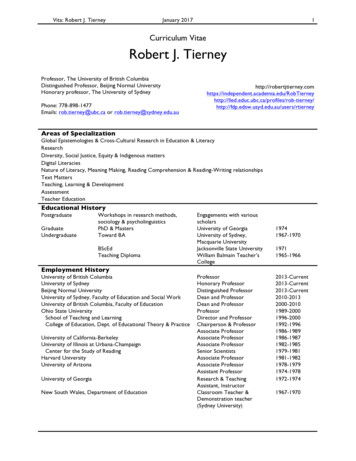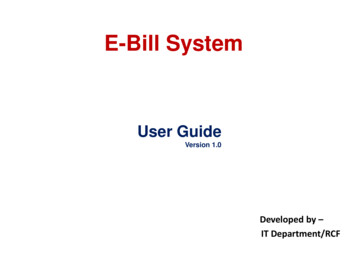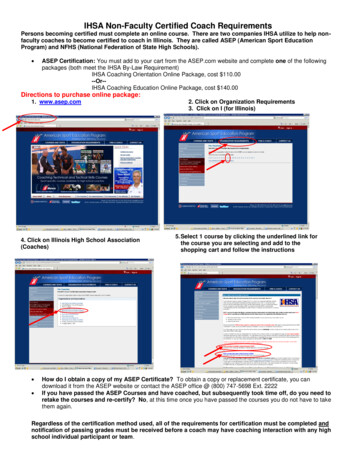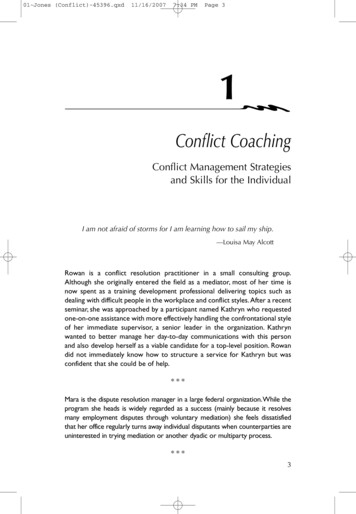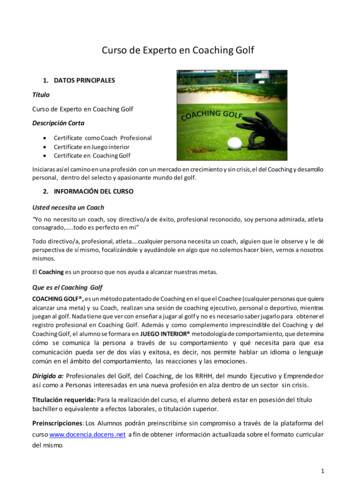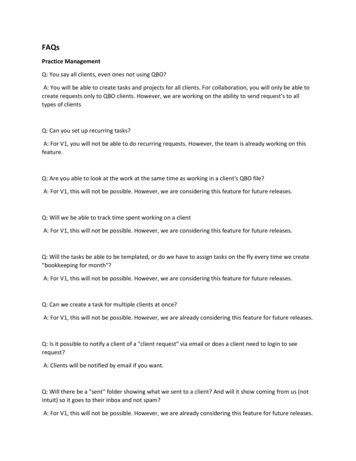
Transcription
“This book is so much more than a workbook! While capturing the key parts ofJay Earley’s Self-Therapy in a workbook format, it also elucidates IFS bestpractices and will be indispensable to IFS students, teachers, clients, coaches, andtherapists.” Everett Considine, IFS Instructor and Certified IFS Practitioner“Self-Therapy Workbook by Bonnie Weiss, LCSW, is a comprehensive,thoughtful and well organized accompaniment for anyone working to build thecapacities of self-leadership. The workbook is an exemplary introduction to theIFS Model for first timers, yet it also brings enough sophistication in detail andscope to benefit professional-level providers. As usual, Ms. Weiss brings acollection of excellent meditations to open the reader’s inner experience as well asplenty of room to record one’s own reflections and progressive growth. I highlyrecommend this workbook for individuals and professions as a valuableenhancement to the therapeutic process.” Roseanne Keefe, LICSW“If you want an easy way to understand and effectively utilize the IFS process,this workbook clearly breaks down the steps described in Self-Therapy by JayEarley. The exercises are clear, the images are helpful and well integrated into thetext, and the examples make this workbook easy to use. I appreciate that it hasexpanded the original work to include chapters on polarization and couples work.I will certainly give this to my clients to both educate them about the IFS processand to empower them to use this process on their own.” Nancy Dagenhart, MFT, IFS Therapist“This workbook is a very useful companion to Self-Therapy. It providesthoughtful step-by-step guidance through the IFS process. Its clarity andsimplicity allow the reader to turn the theoretical concepts of IFS into practical,useful steps toward healing. A must-read for those who want to use IFS for selfgrowth and healing.” Ilyssa Bass, IFS Therapist, Jerusalem, Israel“This book is a gold mine. It takes the excellent Self-Therapy book to the nextlevel in terms of practicality. I’m convinced that this workbook will help itsreaders process and work through inner blocks and recurring pains. It is areference I will use personally as well as recommend to my clients.” Ronnie Grandell, Psychologist, Finland
Self-Therapy WorkbookAn Exercise Book for the IFS ProcessBonnie J. Weiss, LCSWLarkspur, CA
SELF-THERAPY WORKBOOK:An Exercise Book for the IFS ProcessCopyright 2013 by Bonnie WeissAll rights reserved.Without limiting the rights under copyright reserved above, no part of thispublication may be reproduced, stored in or introduced into a retrievalsystem, or transmitted, in any form or by any means (electronic, mechanical,photocopying, recording, or otherwise), without the prior written permissionof both the copyright owner and the above publisher of this book.140 Marina Vista Ave.Larkspur, CA 94939415-924-5256www.patternsystembooks.comISBN: 978-0-9843927-4-2Printed in the United States of America
ACKNOWLEDGMENTSI primarily want to thank Jay Earley for his generosity in allowing me to use his materialas a basis for this book. I appreciate his support for this vision and his tireless commitmentto bringing the healing concepts of IFS to the larger public.It was great fun spending a weekend writing the couples chapter with my dear friendMarla Silverman. Any time with Marla is treasured time well spent. We always depend onKira Freed for editing and, in this case, design. We love her sharp eye, open heart, and clearlanguage. Thank you for always making time for our projects.I deeply appreciate Alexis Zielke’s creative input and loving support on this project. I sovalue her fresh point of view. As usual, Jeanenne Chase Langford and MJ Stern are alwaysthere to pick up pieces and move things along. I am grateful for their support. Thanks againto Karen Donnelly for the use of her illustrations. I have always valued the way they makethe concepts come alive.
Table of ContentsList of Exercises . . . . . . . . . . . . . . . . . . . . . . . . . . . . . . . . . . . . . . . . . . . . . . . . . . . . . . . . ixIntroduction . . . . . . . . . . . . . . . . . . . . . . . . . . . . . . . . . . . . . . . . . . . . . . . . . . . . . . . . . . . . 1Chapter 1Basic IFS Concepts . . . . . . . . . . . . . . . . . . . . . . . . . . . . . . . . . . . . . . . . . . . 3Chapter 2Guided Meditations . . . . . . . . . . . . . . . . . . . . . . . . . . . . . . . . . . . . . . . . . . 7Chapter 3The Self . . . . . . . . . . . . . . . . . . . . . . . . . . . . . . . . . . . . . . . . . . . . . . . . . . . . 9 IFS Steps Working with Protectors . . . . . . . . . . . . . . . . . . . . . . . . . . . . . . . . . . . . 13Chapter 4Accessing Parts . . . . . . . . . . . . . . . . . . . . . . . . . . . . . . . . . . . . . . . . . . . . 15Chapter 5Unblending & Conscious Blending . . . . . . . . . . . . . . . . . . . . . . . . . . . 27Chapter 6Checking for Self-Leadership& Unblending from Concerned Parts . . . . . . . . . . . . . . . . . . . . . . . . . 37Chapter 7Getting to Know a Protector . . . . . . . . . . . . . . . . . . . . . . . . . . . . . . . . 45Chapter 8Developing a Trusting Relationship with a Protector . . . . . . . . . . . . 49Chapter 9When a Protector Doesn’t Trust You . . . . . . . . . . . . . . . . . . . . . . . . . . 57Chapter 10 Session Basics . . . . . . . . . . . . . . . . . . . . . . . . . . . . . . . . . . . . . . . . . . . . .Starting a New IFS Session . . . . . . . . . . . . . . . . . . . . . . . . . . . . . . . . . .Triggered Parts . . . . . . . . . . . . . . . . . . . . . . . . . . . . . . . . . . . . . . . . . . . .Speaking For a Part Versus Speaking As a Part . . . . . . . . . . . . . . . . .Parts Detection . . . . . . . . . . . . . . . . . . . . . . . . . . . . . . . . . . . . . . . . . . . .6161616264 IFS Steps Working with Exiles . . . . . . . . . . . . . . . . . . . . . . . . . . . . . . . . . . . . . . . . 67Chapter 11 Getting Permission to Work with an Exile . . . . . . . . . . . . . . . . . . . . . 69Chapter 12 Unblending from an Exile . . . . . . . . . . . . . . . . . . . . . . . . . . . . . . . . . . . 73Chapter 13 Getting to Know an Exile . . . . . . . . . . . . . . . . . . . . . . . . . . . . . . . . . . . 79Chapter 14 Accessing & Witnessing Childhood Origins . . . . . . . . . . . . . . . . . . . 87Chapter 15 Reparenting an Exile . . . . . . . . . . . . . . . . . . . . . . . . . . . . . . . . . . . . . . . 93Chapter 16 Retrieving an Exile . . . . . . . . . . . . . . . . . . . . . . . . . . . . . . . . . . . . . . . . 101Chapter 17 Unburdening an Exile . . . . . . . . . . . . . . . . . . . . . . . . . . . . . . . . . . . . . 107Chapter 18 Integration & Unburdening Protectors . . . . . . . . . . . . . . . . . . . . . . . 113
Chapter 19 Ending a Session . . . . . . . . . . . . . . . . . . . . . . . . . . . . . . . . . . . . . . . . . 121Chapter 20 Working with a Partner . . . . . . . . . . . . . . . . . . . . . . . . . . . . . . . . . . . . 123Chapter 21 IFS with Couples, with Marla Silverman, PhD . . . . . . . . . . . . . . . . . 129Chapter 22 Working with Polarized Parts . . . . . . . . . . . . . . . . . . . . . . . . . . . . . . . 141Managers and Firefighters . . . . . . . . . . . . . . . . . . . . . . . . . . . . . . . . . . 142Appendix A Help Sheets . . . . . . . . . . . . . . . . . . . . . . . . . . . . . . . . . . . . . . . . . . . . . . 155Appendix B Meditations . . . . . . . . . . . . . . . . . . . . . . . . . . . . . . . . . . . . . . . . . . . . . . 161Appendix C Definitions of Terms . . . . . . . . . . . . . . . . . . . . . . . . . . . . . . . . . . . . . . 167Appendix D Resources . . . . . . . . . . . . . . . . . . . . . . . . . . . . . . . . . . . . . . . . . . . . . . . . 169
List of ExercisesAccessing a Part That Isn’t Activated . . . . . . . . . . . . . . . . . . . . . . . . . . . . . . . . . . . . . 17Identifying the Parts at a Trailhead . . . . . . . . . . . . . . . . . . . . . . . . . . . . . . . . . . . . . . . 19Identifying the Parts in Your Current Experience . . . . . . . . . . . . . . . . . . . . . . . . . . 21Noticing a Part in Real Time . . . . . . . . . . . . . . . . . . . . . . . . . . . . . . . . . . . . . . . . . . . . 23Blending . . . . . . . . . . . . . . . . . . . . . . . . . . . . . . . . . . . . . . . . . . . . . . . . . . . . . . . . . . . . . . 28Unblending from a Target Part . . . . . . . . . . . . . . . . . . . . . . . . . . . . . . . . . . . . . . . . . . 30Reluctance to Unblend . . . . . . . . . . . . . . . . . . . . . . . . . . . . . . . . . . . . . . . . . . . . . . . . . 32Daily Parts Check-In . . . . . . . . . . . . . . . . . . . . . . . . . . . . . . . . . . . . . . . . . . . . . . . . . . . 33Conscious Blending . . . . . . . . . . . . . . . . . . . . . . . . . . . . . . . . . . . . . . . . . . . . . . . . . . . 35Unblending from a Concerned Part . . . . . . . . . . . . . . . . . . . . . . . . . . . . . . . . . . . . . . 40Mapping Your Parts . . . . . . . . . . . . . . . . . . . . . . . . . . . . . . . . . . . . . . . . . . . . . . . . . . . 43Getting to Know a Protector . . . . . . . . . . . . . . . . . . . . . . . . . . . . . . . . . . . . . . . . . . . . 45Developing a Relationship with a Protector . . . . . . . . . . . . . . . . . . . . . . . . . . . . . . . 50Helping a Protector to Relax in Real Time . . . . . . . . . . . . . . . . . . . . . . . . . . . . . . . . 53Speaking for Parts . . . . . . . . . . . . . . . . . . . . . . . . . . . . . . . . . . . . . . . . . . . . . . . . . . . . . 62Detecting a Part That Has Taken Over . . . . . . . . . . . . . . . . . . . . . . . . . . . . . . . . . . . . 65Making Initial Contact with an Exile . . . . . . . . . . . . . . . . . . . . . . . . . . . . . . . . . . . . . 70Unblending from an Exile . . . . . . . . . . . . . . . . . . . . . . . . . . . . . . . . . . . . . . . . . . . . . . 75Getting to Know an Exile . . . . . . . . . . . . . . . . . . . . . . . . . . . . . . . . . . . . . . . . . . . . . . . 80Finding Out About an Exile . . . . . . . . . . . . . . . . . . . . . . . . . . . . . . . . . . . . . . . . . . . . . 82Noticing an Exile in Real Time . . . . . . . . . . . . . . . . . . . . . . . . . . . . . . . . . . . . . . . . . . 84Accessing and Witnessing a Childhood Memory . . . . . . . . . . . . . . . . . . . . . . . . . . . 89Reparenting an Exile . . . . . . . . . . . . . . . . . . . . . . . . . . . . . . . . . . . . . . . . . . . . . . . . . . . 94Reparenting an Exile in Real Time . . . . . . . . . . . . . . . . . . . . . . . . . . . . . . . . . . . . . . . 97Retrieving an Exile . . . . . . . . . . . . . . . . . . . . . . . . . . . . . . . . . . . . . . . . . . . . . . . . . . . 103Unburdening an Exile . . . . . . . . . . . . . . . . . . . . . . . . . . . . . . . . . . . . . . . . . . . . . . . . . 109
x Self-Therapy WorkbookReleasing a Protector . . . . . . . . . . . . . . . . . . . . . . . . . . . . . . . . . . . . . . . . . . . . . . . . . 116Follow-Up with a Protector . . . . . . . . . . . . . . . . . . . . . . . . . . . . . . . . . . . . . . . . . . . . 119Tracking Repetitive Interactions . . . . . . . . . . . . . . . . . . . . . . . . . . . . . . . . . . . . . . . . 132Tracking Feelings During Dialogue . . . . . . . . . . . . . . . . . . . . . . . . . . . . . . . . . . . . . 135Tracking the Parts That Hold Feelings . . . . . . . . . . . . . . . . . . . . . . . . . . . . . . . . . . . 138Exploring a Polarization . . . . . . . . . . . . . . . . . . . . . . . . . . . . . . . . . . . . . . . . . . . . . . . 151
INTRODUCTIONThis workbook is a companion book to Self-Therapy by Jay Earley, PhD. Self Therapylays out the step-by-step process of the Internal Family Systems Therapy Model originated by Richard Schwartz, PhD (www.selfleadership.org). The book is designedto facilitate learning the basics of the IFS process. The workbook takes you step-bystep from accessing a part by working with Protectors through getting to know andheal the more fragile, exiled parts of the psyche. The format of integrated conceptdescriptions and exercises is ideal for individual exploration, small groups, or classes. Exercises can be done on one’s own or with a partner. The workbook structureallows for journal-style following of your process.The workbook provides summaries of the steps outlined by Earley and offers expanded exercises to work with and integrate the IFS process. Sample responses tothe exercises are provided in order to clarify the ideas being explored. The workbookgoes beyond Self-Therapy by including chapters on using IFS with couples, polarization, and firefighters. For a fuller explanation of various IFS ideas, transcripts of sessions and case examples refer to Self-Therapy.As clinicians, Jay and I were very excited to discover the IFS Model. It allowed usto integrate our training and clinical experience with our years of spiritual practice.The concept of Self brings into the therapeutic arena the power of higher consciousness as a healing tool. We are deeply grateful to Dick Schwartz for his unflaggingcommitment to bring this model into the world.Over the years of teaching the IFS Model and using it with clients, Jay and I haveprovided user-friendly materials that enable people to use the powerful tools of IFSin their individual efforts to grow and develop their humanness as well as to transform personal difficulties. Being psychotherapists, we deeply value the importanceof the helping relationship and the sacredness of the therapeutic encounter. We do,however, believe that people can benefit from being introduced to this model outside
2 Self-Therapy Workbookof therapy and can work by themselves or with a partner to further their personal understanding and gain some relief from internal structures that have limited their ability to function in a satisfying way. Our hope is that this workbook will supplementexisting material by providing a clear, easy-to-follow structure for doing IFS work.Downloadable exercise pages that accompany this workbook are available -workbook-bonnie-weiss/
Chapter 1BASIC IFS CONCEPTSInternal Family Systems (IFS) is a relatively new form of therapy that is compassionate, inclusive, spiritual, powerfully healing, and deeply respectful of our inner life.IFS recognizes that our psyches are made up of different parts, sometimes calledsubpersonalities. You can think of them as little people inside us. Each part has itsown perspective, feelings, memories, goals, and motivations. For example, one partof you might be trying to lose weight, and another part might want to eat whateverit wants. We can all recognize parts like the Inner Critic, the Abandoned Child, thePleaser, the Angry Part, and the Loving Caretaker.Parts have motivations for everything they do. Nothing is done just out of habit.Nothing is just a pattern of thinking or behavior that you learned. Everything(except for purely physiological reactions) is done by a part for a reason, even thoughthat reason may be unconscious.Understanding parts in this way gives you a great deal of power to change yourinner system. It means that there is an understandable rationale for your behavior,feelings, and attitudes. It is possible to get to know these parts, develop relationshipswith them, and help them heal. Once healed, they no longer need to behave in waysthat seem at odds with your intentions, values, and goals. The possibility for harmonious integration is real.Richard Schwartz, PhD, in developing the IFS method, discovered that every parthas a positive intent for you, no matter how problematic its behavior. For example,Bill had a part that was judgmental and competitive with other people in a way thatwas not consistent with his true values. However, when he really got to know thatpart, he discovered that it was just trying to help him feel OK about himself in theonly way it knew how—by feeling superior to others.Understanding that a part has positive intent doesn’t mean that you give the partpower. Bill doesn’t want his part to act out being judgmental and competitive. Using
4 Self-Therapy Workbookthe IFS approach, Bill can relate to this part with understanding and appreciationwhile also taking the steps to heal it.This approach is fundamentally different from the way we ordinarily relate to ourparts. Usually when we become aware of a part, the first thing we do is evaluate it. Isit good or bad for us? If we decide it is good, we embrace it and give it power. If wedecide it is bad, we try to suppress it or get rid of it. The truth is, you can’t get rid ofa part. You can only push it into the deeper layers of your psyche, where it will continue to affect you without your awareness.In IFS, we do something altogether different and radical. We welcome all our partswith curiosity and compassion. We seek to understand them and appreciate theirefforts to help us. We develop a relationship of caring and trust with each part andthen take the steps to release it from its burdens so it can function in a healthy way.In the IFS system, Protectors are the parts you usually encounter first in exploring yourself. Their job is to handle the world, protect you, and keep you functioning.They interact in a reasonable, strategic way with the people, responsibilities, andsituations in your environment. The other main function of these parts is to protectyou from the pain of the Exiles. These are young child parts that hold the pain fromthe past. They are generally exiled, or kept out of consciousness, by the Protectors.In the above example, Bill had a Protector that was competitive and judgmentaltoward others. It was trying to help Bill feel superior in order to protect against anExile Part that felt inadequate. The Exile Part had probably suffered some kind ofhumiliation or rejection in the past that left it feeling unworthy.Parts take on these dysfunctional roles because of what has happened to them inthe past. Exiles take on pain and burdens from what they experienced as children.Protectors take on their roles in order to protect Exiles or to protect you from thepain of Exiles.The IFS ProcessIFS has a method of understanding and working with these parts to release theburdens they carry from the past and heal the system so you can function in healthyways. The key to this healing is the Self. IFS recognizes that each of us has a spiritualcenter—a true Self. This Self is naturally compassionate and curious about people,
Basic IFS Concepts 5especially about our own parts. The Self wants to connect with each part and get toknow and understand it. The Self feels compassion for the pain of the Exiles and theburdens of pain that they carry. It also has compassion for the Protectors and thetough jobs they take on trying to keep the Exiles from being reinjured or exposed.The Self is able to stay calm and centered despite the sometimes intense emotionsthat parts may feel. Everyone has a Self, even though you may feel that yours is notvery accessible at times because of the activity of your parts.The Self is the agent of healing—the true leader of the internal system that canlove and heal each part. The first step in the IFS process is learning how to access theSelf. Then the Self focuses its energy on the part. In Bill’s case, he started out his IFSwork by focusing on his Judgmental Part. With some work, he was able to be genuinely in his Self so that he was interested in getting to know the Judgmental Part. Hefound out that it was trying to protect an Exile Part of him that felt inadequate. Billhad a learning problem as a child, even though he is quite intelligent and competent.So there was a young part of Bill that had felt inadequate in school. The JudgmentalPart was trying to compensate for this inadequate experience by feeling superior topeople. Bill had grown up in a judgmental, competitive home, so that was the primary model this part knew. As Bill got to know the Judgmental Part, he understoodwhy this part acted as it did and appreciated its efforts on his behalf.He then contacted the Exile who felt inadequate. He listened and watched as thispart showed him scenes from his childhood when it felt ashamed and inadequatebecause of his learning problem, and he responded to the Exile with compassionand caring. The young part responded to this by feeling cherished and valuable forthe first time. Up until then, it had been hidden away in Bill’s unconscious, whichonly increased its feelings of worthlessness. With love from Bill’s Self, this young partwas able to release the burden of inadequacy that it had been carrying and feel goodabout itself. This allowed the Judgmental Protector to relax. It no longer neededto judge people to compensate for the Exile’s pain. This enabled Bill to respond topeople in the way he always wanted—with openness, acceptance, and a cooperativeattitude.
6 Self-Therapy WorkbookIFS PrinciplesThe following are some basic principles of the Internal Family Systems Model.These concepts underlie the work described in this workbook. All parts are welcome. You never make a part step aside or separate—you only ask. You respect the reasons parts have for what they are and aren’t willing to do. All parts have positive intent at their core and ultimately want only the bestfor you. If they appear to have negative intent, they are using strategies that,on some level, made sense at some point in their past but are no longereffective. Getting inside their world and understanding the origin of thosestrategies is a key step in helping them adopt more effective strategies. Parts will cooperate once their fears are addressed and once they can feelyou in Self and understand your intentions. It isn’t possible to do it wrong when working on yourself using IFS. Even ifyour process is completely blocked, it just means that a Protector is stoppingthe process for some reason. You access that Protector and find out why itis behaving that way. The fastest way to resolve an issue is to work slowly, patiently, and respectfully with all parts involved.
Chapter 2GUIDED MEDITATIONSA guided meditation is an audio journey that evokes an altered state of consciousness during which material from the deeper layers of your psyche is more readilyavailable to you. Three audio recordings of guided meditations are included withthis book: Getting into Self Appreciating Protectors Soothing a Triggered ExileThey can be accessed at rkbook-bonnie-weiss/. The transcripts for these meditations are located in Appendix B.When doing this kind of imagery exercise, it is best to sit or lie in a completelyrelaxed, comfortable position. Never listen to guided imagery while driving or doinganything that requires full alert attention. If you discover that you have a tendencyto fall asleep during guided meditations, it is best to maintain an upright sittingposition without head support. This will keep you awake while still allowing deeprelaxation. It is especially important to use this position after eating a big meal or ifyou are tired.The best attitude to adopt for guided meditations is a combination of letting goand staying focused. Letting go allows images from the deeper layers of your psycheto emerge freely. There is no need to try to control the images or sensations thatyou feel or the words that you hear. It’s important not to doubt or discard whateverspontaneously emerges. You might be inclined to discard something because youdon’t understand it or you think it is unacceptable. Sometimes it is actually a plus tohave something emerge that is not immediately clear. Some of the most importantinformation from our psyche isn’t readily understandable. When we allow ourselves
8 Self-Therapy Workbookto be with things we’re initially inclined to reject, new avenues of self-understandingcan emerge. Please trust that the image or other information has come up for a goodreason and that you don’t need to fear your psyche.The other important ability is staying focused. This means keeping on track withthe meditation directions as well as with the thread of your own inner journey. During meditation, it is easy to “space out” or daydream about irrelevant issues. Thishappens to almost everyone from time to time. If you find that you have lost focus,don’t become worried or judge yourself—just gently bring yourself back to the trackof the meditation.Don’t assume that all imagery has to be visual. Some people don’t visualize verywell but are good at body imagery. They can sense body feelings, posture, and movement, and they may also imagine their body in different shapes. This is called kinesthetic imagery. Some people have profound meditative experiences this way. Otherpeople mainly get information through hearing voices, words, or sounds. So if youhave trouble visualizing, just notice what information is coming through these otherchannels.
Chapter 3THE SELFA downloadable guided meditation that facilitatesgetting into Self is available in MP3 format -workbook-bonnie-weiss/Fortunately, human beings are not simply a collection of parts. We are so much morethan that. Our true Self is mature and loving, and has the capacity to heal and integrate our parts.We each have a core aspect of us that is our true self and our spiritual center.When our extreme parts are not activated and getting in the way, we have access tothis core, which is who we really are. The Self is relaxed, open, and accepting of others and ourselves. When we are in Self, we are grounded, centered, and nonreactive.We don’t get triggered by what people do. We remain calm and unruffled, even indifficult circumstances. The Self is so much larger and more spacious than our partsand is not frightened by events that would scare parts. When we are in Self, we arethe shining center of the system that is each of us.The IFS Model talks about the eight C’s that are the principal qualities of theSelf. They are: Compassion, Curiosity, Connection, Calm, Courage, Clarity, Caring,and Creativity. The four capacities described on the next page are the most relevantfor doing an IFS session.Self Capacities Compassion Curiosity CourageSelf Clarity Connection Caring Calm Creativity
10 Self-Therapy Workbook1. The Self is connected. When you are in Self, you naturally feel close to otherpeople and want to relate in harmonious, supportive ways. You are drawn tomake contact with them and to be in community. The Self also wants to beconnected to your parts. When you are in Self, you are interested in having arelationship with each of your parts, which helps them trust you and opens theway for healing.2. The Self is curious. When you are in Self, you are curious about other peoplein an open, accepting way. When you inquire into what makes them tick, it’sbecause you want to understand them, not judge them. The Self is also curious about the inner workings of your mind. You want to understand why eachpart acts as it does, what its positive intent is for you, and what it is trying toprotect you from. This curiosity comes from an accepting place, not a critical one. When parts sense this genuine interest, they know they are enteringa welcoming environment, and they aren’t afraid to reveal themselves to you.3. The Self is compassionate. Compassion is a form of kindness and love thatarises when people are in pain. You genuinely care about how others feel andoften feel prompted to support them through difficult times. When you are inSelf, you also naturally feel compassion for yourself. When parts are extreme,they’re reacting to pain; Exiles feel it, and Protectors try to avoid it. Compassion toward yourself is the most essential ingredient in the inner quest forunderstanding. It is needed in order to hold, support, and nurture your partswhile you explore your system. Your parts can sense the Self ’s compassion.It makes them feel safe and cared for, so they want to open up and share themselves with you.4. The Self is calm, centered, and grounded. This is especially helpful whenyou are relating to a part that has intense emotions. Intense grief or shame, forexample, can be overwhelming if you aren’t grounded in Self. Protectors willavoid a part that has very strong emotions. But when you are centered in thecalmness of Self, there is no need to avoid a part that is feeling intense emotion. You remain in Self while the part shows you its pain. The calmness of Selfsupports you through the difficult work of witnessing and healing the part.
The Self 11For all these reasons, the Self is the agent of psychological healing in IFS work.It helps you heal and transform your parts so they become free of their extreme feelings and behavior, and can assume healthy roles in your life.The Structure of the PsycheThe Self is also the natural leader of your internal system and the natural occupant of the “seat of consciousness.” It has the courage to take risks, the perspective toSelfsee reality clearly, and the creativity to find good solutionsto problems. The Self is balanced and fair, and it sees whatneeds to happen in most situations. When you have healedyour parts and they trust you, they finally allow the Selfto lead. Ideally the Self is the one who makes decisionsand moves the system forward. The Self is the conductorof the orchestra, the one who brings in the woodwinds at the right time, tells themusicians when to play softly, and cues the horn solo. It chooses the best course ofaction in each moment and calls on your healthy parts to contribute their gifts. Yourparts trust the Self and rely on its wisdom.The goal of IFS work is to unburden each part so it has a healthy role and for eachpart to trust the Se
This workbook is a companion book to Self-Therapy by Jay Earley, PhD. Self Therapy lays out the step-by-step process of the Internal Family Systems Therapy Model orig - inated by Richard Schwartz, PhD (www.selfleadership.org). The book is designed to facilitate learning the basics of the IFS process. The workbook takes you step-by-
